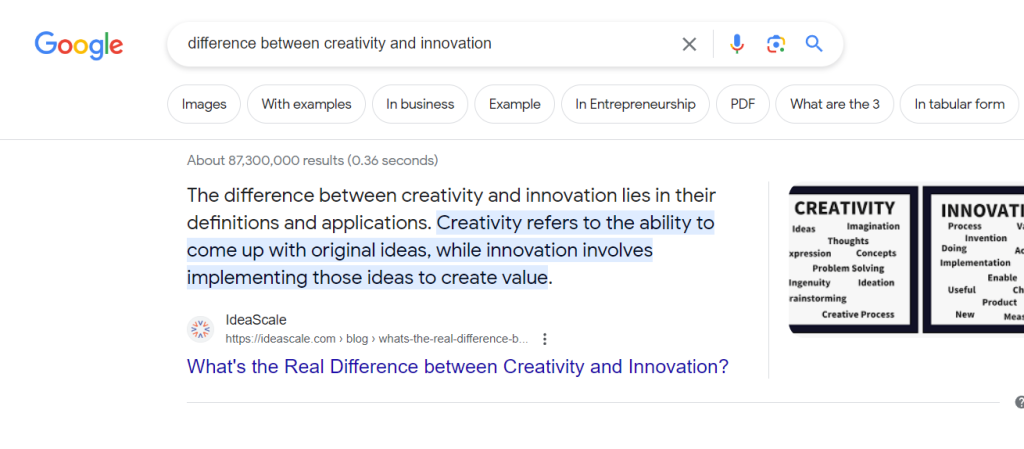
Introduction
The problem I am about to address is the misunderstanding around the concept of creativity and innovation and how they relate. This will help you understand why creativity and innovation is important in business and work.
Most people tend to confuse what creativity means and this makes it difficult for them to properly understand the concept of innovation and how it relates to creativity. So let’s dive right in.
Understanding Creativity and Innovation
Whether you’re a small start-up or an established enterprise, understanding and leveraging these two powerful drivers can propel your work or business to new heights. With the right mix of creativity and innovation, you can break free from the norm, generate fresh ideas, and transform them into tangible results.
Click to jump ahead
ToggleWhat is the Difference Between Creativity and Innovation?
Several years ago when I took interest into the subject of creativity, I did not find satisfactory information online that could really give a good insight into the subject.
Most information I found online were either half-baked truth or well baked ignorance. I say this with due respect to those who have put out content to try to answer the pressing questions millions of people have on creativity.
I am sharing this here because of my desire to help readers get the correct perspective and understanding of what creativity is about. So in this blog, I will start by presenting some information before you.
All I ask is that you examine the information with critical thinking so that by the end of this article, you will have a better understanding.
Additional Resource To Boost Your Creativity
- 2 Mistakes To Avoid When Solving Problems at Work
- Where Do Creative Ideas Come From? [10 Channels Everyone Can Tap Into]
- Where Do Innovative Ideas Come From? 6 Channels
- The 2 Basic Differences Between Creativity and Innovation
- 5 Steps To Break the Curse of Creativity [What, Why and How to Unlock Your Potential]
So I did a Google search for the difference between creativity and innovation and some popular sites provided answers.

As you can see above, this is the first resource that popped up when I put in those search words. It says that creativity refers to the ability to come up with original ideas.
Other popular and renowned blogs like Harvard Business Review also popped up and effectively say the same thing in response to my search query.

Even though the sources are credible and I respect them for their contribution to the knowledge industry, I would like to respectfully disagree with the definition given by these reputable sources on creativity. Sadly, this is what most people believe creativity is about – “coming up with big ideas”, but creativity is much more than that.
Creativity does not stop at having great ideas. In my book titled “Unlocking Your Kingdom Creativity“, I explained this concept with this illustration:
If you are full of ideas but do not act on them, it means you are not yet creative. If a woman receives seed and gets pregnant with child but fails to put to bed for whatever reason, and the baby dies inside her womb, she has not procreated.
The procreation cycle is not complete until what is inside the womb matures and comes out alive. It does not matter how many fetuses have been conceived in the womb of a woman, if none of them were allowed to come out of the womb for the world to see, that family may remain childless.

- Unlocking Your Creativity Book
You can get Unlocking Your Creativity on Amazon here.
Creativity involves two fundamental steps for the cycle to complete namely: thinking and then producing. Without the aspect of producing, creativity is incomplete. Creativity is the process of bringing something new into existence. It requires turning the ideas of one’s imagination into a tangible or visible reality and in a novel manner.
A creative person sees the world in new ways. He has the ability to find hidden patterns, make connections between what seems unrelated, and to generate solutions.
The moment you understand this, it becomes easier to see the connection between creativity and innovation in business and career.
Creativity vs Innovation : The Relationship
Now, what is innovation and how is it related to creativity?
Innovation often involves taking existing ideas, concepts, or technologies and recombining them in new and creative ways to bring about novel solutions. This process can lead to improved efficiency, effectiveness, or even entirely new products or services.
Creativity, on the other hand, includes the recombination of existing ideas and goes beyond that.
Creativity also involves the generation of entirely new and original ideas and turning them into reality.
These ideas can be raw and untested. Creativity involves nurturing them and turning them into practical solutions or tangible realities.
For more insights on innovation, see: Innovation vs Tradition – 7 Keys to Breaking out of the Box
Is Creativity and Innovation the Same?
In a nutshell, the concept of creativity and innovation are related but not exactly the same. Innovation is a subset of creativity. Innovation involves taking existing ideas, concepts, or technologies and recombining them in new and creative ways to bring about novel solutions.
On the other hand, creativity is a broader concept that encompasses both the generation of fresh and original ideas.
It also includes the innovative recombination of existing concepts. While creativity specifically focuses on the implementation of those ideas to create real-world impact and value.
If you would like to do a more intimate study on creativity, I recommend you read “Ignite Your Creativity“. Or grab it on Amazon here.

Why is Creativity and Innovation Important in Business and Work?
Creativity and innovation might sound like big words, but they’re basically the cool stuff that makes work and business better. Let’s break it down so it’s crystal clear:
1. Cracking Tough Problems:
When you face a problem that feels like a wall, creativity and innovation are like a ladder to climb over it. They help you find new ways to solve problems, even ones that seem really tricky.
2. Fresh Ideas, Exciting Vibes:
Doing the same old things can be as boring as eating the same food every day. But when you add creativity and innovation, it’s like adding new flavors to your work and business. Everything becomes more exciting and interesting.
3. Getting More Customers:
Think about stores – some sell regular stuff, and some sell really cool things you can’t find anywhere else. That’s the power of innovation. It helps your business stand out and attract more customers, like a magnet.
4. Growing Stronger:
Innovation is like the way plants grow towards the sun. It helps your business grow and become better. If you’re not growing, you’re kind of stuck, right? Innovation is like a growth spurt for your business.
5. Standing Out from the Crowd:
When everyone is the same, standing out is like wearing a neon jacket in a black-and-white world. Creativity helps you stand out. It makes your work and business special and unique.
6. Bringing Joy to Work:
Imagine if work was as fun as your favorite hobby. Creativity can make that happen. It brings fun and excitement to work, making it a place you look forward to every day.
7. Learning Made Awesome:
Learning new stuff can feel like eating veggies when you want pizza. But innovation makes learning cool. It brings in new ways to learn, making it more interesting and enjoyable.
8. Fighting Boredom:
Boredom at work is like watching paint dry. But creativity and innovation are like a superhero team that fights boredom. They keep things interesting and make sure you’re never bored.
9. Getting Ready for Anything:
Think of your business like a house. Creativity and innovation are like strong walls that protect it from being knocked out by inevitable change. They help your business handle whatever comes its way.
10. Turning Dreams into Reality:
You know those big dreams you have? Creativity and innovation are like the magic that turns them into real plans. They help you make your dreams come true.
So, creativity and innovation? They’re the cool tools that make work more exciting, solve problems like a pro, and turn your ideas into something awesome. They’re not just big words; they’re the friends your work and business can’t do without.

What are the Benefits of Fostering a Creative and Innovative Culture in the Workplace?
A creative and innovative culture can bring a multitude of benefits to businesses of all sizes. Firstly, it fosters a sense of adaptability and agility.
In today’s fast-paced world, businesses must be able to quickly respond to changing market conditions and customer demands. A creative and innovative culture enables businesses to think on their feet, adapt to new challenges, and seize opportunities as they arise.
Secondly, a creative and innovative culture encourages collaboration and teamwork. When employees are given the freedom to think creatively and share their ideas, it creates an environment where diverse perspectives and talents can come together.
This collaborative approach not only leads to better problem-solving but also fosters a sense of ownership and belonging among employees.
Furthermore, a creative and innovative culture attracts and retains top talent. In a world where job seekers are looking for more than just a paycheck, businesses that value and promote creativity and innovation are seen as more attractive employers.
Employees want to work in an environment that stimulates their creativity and allows them to make a real impact.
How can you Cultivate Creativity and Innovation in the Workplace?
Cultivating creativity and innovation starts with leadership. Leaders play a crucial role in setting the tone and creating an environment that encourages and rewards creative thinking. They must lead by example, demonstrating a willingness to take risks, embrace change, and support their teams in their creative endeavors.
One way to foster creativity and innovation is to provide employees with the time and space to think. This can be done through dedicated brainstorming sessions, innovation labs, or even allowing flexible work hours that give employees the freedom to pursue their creative interests. Creating a physical environment that stimulates creativity, such as open and collaborative workspaces, can also have a positive impact.
Another important aspect is creating a culture that values and celebrates failure. Failure is an inevitable part of the innovation process, and businesses that are afraid to fail will never truly innovate. Encouraging a growth mindset, where failures are seen as learning opportunities, can help create a culture that embraces experimentation and risk-taking.
To understand what creativity truly means, see: What is Creativity? Here is My Powerful 7-Sided Definition!
5 Techniques for Generating Creative Ideas
Generating creative ideas is a skill that can be developed with practice. Here are some techniques that can help stimulate creative thinking:
1. Brainstorming:
Get a group of people together and encourage them to generate as many ideas as possible, without judgment or criticism. The goal is to generate a wide range of ideas, even if some may seem far-fetched or unrealistic.
2. Mindstorming:
Start with a central idea or problem and create a visual map of related ideas and associations. This can help uncover new connections and perspectives. For more insights on mindstorming, see: 6 Easy Steps to Solve Problems with Mindstorming.
3. Reverse Thinking:
Instead of asking how to solve a problem, ask how to create the problem. This can help break free from conventional thinking and open up new possibilities.
4. 4D Thinking:
This technique prompts you to think about different ways to approach a problem or improve an existing solution. There are several dimensions of thinking.
There are zero dimensional thinkers, one-dimensional thinkers, two-dimensional thinkers, three-dimensional thinkers and fourth dimensional thinkers.
More insights about this concept can be discovered in my new book titled 4D Thinking.
You can get a digital copy of this book “4th Dimensional Thinking” here.

5. Role Play:
Imagine yourself in someone else’s shoes, such as a customer or a competitor. This can help you see things from a different perspective and generate fresh ideas.
Overcoming Obstacles to Creativity and Innovation
While creativity and innovation can bring immense value to businesses, they are not without their challenges. Some common obstacles to creativity and innovation include:
1. Fear of Failure:
The fear of failure can hinder creative thinking and prevent employees from taking risks. Creating a culture that embraces failure as a learning opportunity can help overcome this obstacle.
2. Lack of Resources:
Limited resources, whether it’s time, money, or manpower, can stifle creative thinking. However, constraints can also be a catalyst for innovation, forcing teams to think outside the box and find innovative solutions.
3. Resistance to Change:
Change can be uncomfortable, and some employees may resist new ideas or ways of doing things. Effective communication and involvement in the decision-making process can help alleviate resistance and create a sense of ownership among employees.
4. Lack of Diversity:
Homogeneous teams tend to think alike, which can limit creativity and innovation. Encouraging diversity in terms of backgrounds, perspectives, and experiences can bring fresh insights and ideas to the table.
Examples of Successful Creative and Innovative Companies
There are numerous examples of companies that have successfully embraced creativity and innovation to drive their success. One such example is Apple Inc. With its innovative products like the iPhone and iPad, Apple revolutionized the tech industry and set new standards for design and user experience.
Another example is Google, known for its “20% time” policy that allows employees to spend a portion of their workweek on projects of their choice. This policy has led to the development of innovative products and features, such as Gmail and Google Maps.
The Role of Leadership in Fostering Creativity and Innovation
Leadership plays a critical role in fostering a culture of creativity and innovation. Leaders must create a safe and supportive environment where employees feel encouraged to take risks and share their ideas. They should set clear goals and expectations, provide resources and support, and celebrate and reward creative thinking.
Moreover, leaders must be open to new ideas themselves. They should be willing to challenge the status quo, encourage experimentation, and lead by example. By nurturing a culture of creativity and innovation, leaders can inspire their teams to think differently and drive positive change.
Leveraging Technology for Creativity and Innovation
Technology has become an indispensable tool for fostering creativity and innovation. From collaboration platforms that enable teams to work together seamlessly to data analytics that provide valuable insights, technology can enhance the creative process and unlock new possibilities.
One example of technology’s role in fostering creativity is virtual reality (VR). VR allows users to immerse themselves in a virtual environment, opening up new avenues for creative expression and problem-solving. It has been used in various industries, from architecture and design to healthcare and entertainment.
Another example is artificial intelligence (AI), which can assist in generating and evaluating ideas. AI-powered algorithms can analyze vast amounts of data and identify patterns and trends, helping businesses make more informed decisions and uncover innovative solutions.
Conclusion: Creativity and Innovation for Career and Business Success
In today’s rapidly evolving world, creativity and innovation are no longer optional. They are essential for businesses seeking a competitive advantage and long-term success. By understanding the interconnection between creativity and innovation and harnessing their potential, businesses can break free from the norm, generate fresh ideas, and transform them into tangible results.
Cultivating a culture of creativity and innovation requires leadership, a supportive environment, and the right tools and techniques. By embracing creativity and innovation, businesses can adapt to change, solve complex problems, and create unique value for their customers.
So, if you’re ready to unlock the full potential of your brand and take it to the next level, now is the time to embrace creativity and innovation. Challenge conventions, ignite your imagination, and revolutionize the way you do business. The possibilities are endless, and the rewards are waiting to be reaped. Embrace the power of creativity and innovation and set your brand on the path to success.
Feel free to drop your questions, feedback and comments in section below. If you would like to invite me to speak at your seminar or event, you can do so on here.



